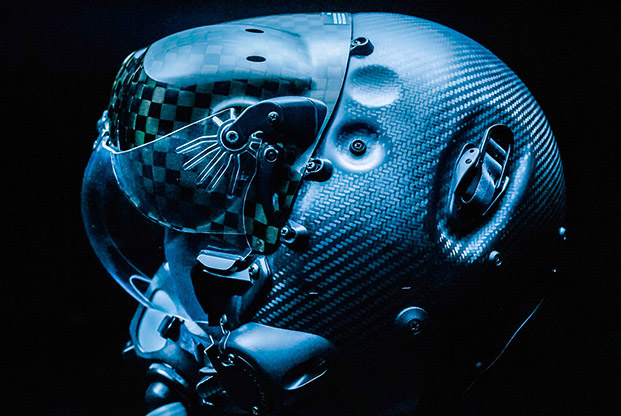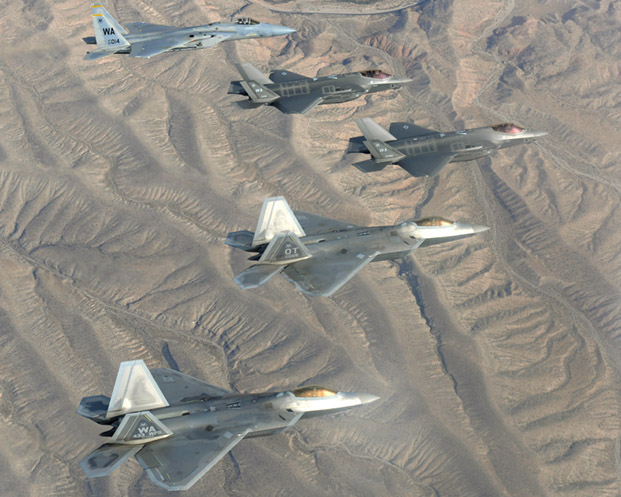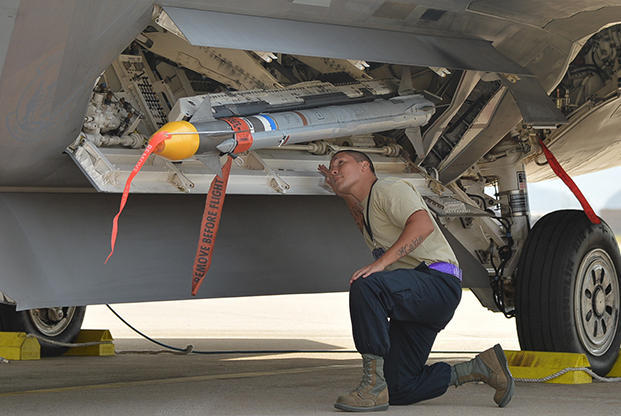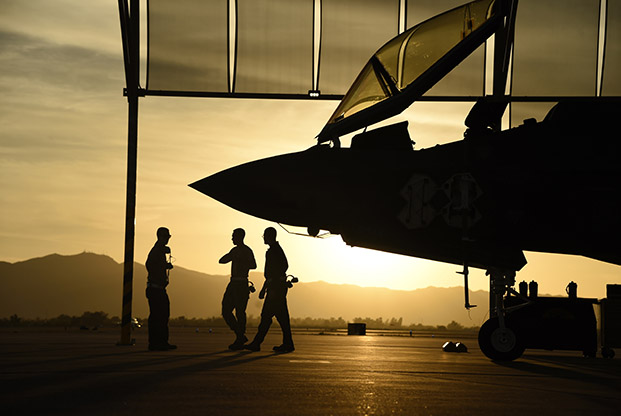
The new F-35 helmet offers a wealth of information—and options—to pilots. Michael McCool/USAF
At the outset of the F-35 Joint Strike Fighter program, there were high expectations that it would benefit from lessons learned from its elder stablemate, the F-22 Raptor, also made by Lockheed Martin.
Now, a dozen years after the F-22’s operational debut and two years after the F-35 was declared ready for combat, the flow of lessons learned is running both ways. The two fifth generation fighter programs are working together to reduce costs and make both systems more effective.
The F-22 has been a pathfinder for the F-35: Its formations and methods of employment are a model for the junior fighter. In return, the small F-22 fleet is gaining economy-of-scale benefits by getting in on parts buys with the far larger—and growing—F-35 fleet. More advanced and hardier stealth features on the F-35 are working their way back to the F-22, the two aircraft share radar features, and operational and manufacturing experience with the F-35 are helping define upgrades for the Raptor.
“The F-35 and F-22 were always meant to operate alongside one another, so it makes a lot of sense to apply that same logic to the programmatic side of both platforms,” said Lockheed Martin F-35 program manager Jeff A. Babione. “We’re constantly taking advantage of newer, more advanced technologies and processes. If we can apply the same advances to the F-35 and F-22, we drive costs down and pull schedules to the left on both programs.”
The F-22 pioneered fifth generation tactics and those are being applied straight to the F-35, according to Col. Paul “Max” Moga, commander of the 33rd Fighter Wing at Eglin AFB, Fla. The 33rd trains new F-35 pilots, but Moga spent years in the F-22, as an instructor and demonstration pilot and later as a squadron commander, after starting out in F-15s.
Regarding employment techniques on the F-22 and F-35, “I would describe them as a direct transfer,” Moga said. In the F-22, the key to employment is “managing signature, sensor, and what we refer to as ‘flow,’?” which he explained is how the plane and pilot sense the battlespace, steer between threats, and get into the optimum position to engage. That same concept applies to the F-35, he said.
Though fourth generation aircraft pilots have to manage visual and infrared signatures, “it’s not until you get in the fifth gen world that you really concern yourselves with radar signature management. … That is a core competency of any fifth gen platform, and that is a direct transfer over from the F-22 to the F-35.” Pilots of both jets must “manage our signature as we employ the aircraft and optimize our survivability and lethality,” Moga said.
The F-22 was a “generational leap” over fourth gen fighters such as the F-15 and F-16, and it took a conscious shift in culture to shed old tactics that were no longer relevant when the F-22 came online, he noted.
In a fourth generation jet, a wingman must provide “mutual support” within visual range, “welded” to the flight lead just a few miles away. But “pretty early on in Raptor tactics development, we realized that, based on the capabilities of the airplane, we didn’t need visual mutual support. We needed a mutual support by presence, which, for us, can be upward of 10, 15, 20 nautical miles away from one another,” said Moga.
For a former fourth gen pilot who has always depended on someone close by having his back, “it takes a while to get used to that,” Moga said.

An F-15 (top), two F-35s, and two F-22s fly in formation over the Nevada Test and Training Range. USAF is looking to field systems that will aid communications between fourth and fifth generation fighters. SSgt. Daryn Murphy
GROWING UP FAST
Now, in the F-35 as well as the F-22, “we train our younger wingmen to operate outside the visual [support] environment, which means they have more responsibilities on their shoulders.” They have to grow up fast, Moga said.
In both jets, “our young wingmen are making tactical decisions and executing accordingly at a level that historically, in our fourth gen fleet, we would not expect out of them until they were a seasoned flight lead, if not a mission commander or instructor pilot,” he assessed.
Fifth gen pilots have to “get up to speed a lot quicker because when they’re by themselves, the consequences can get dire if they make an improper or incorrect tactical decision.” There’s no “safety net” of “somebody being two miles away from them that can clean somebody off their six o’clock,” he noted.
This is all made possible by the extraordinary sensor capability in both aircraft that draws information from both onboard and offboard sensors and from the sensors of their wingmen’s jets. “You no longer need four … or eight sets of eyeballs to scan the horizon and look for threats and put together the tactical picture that you need to execute. … The aircraft does all that for you,” he explained. In fact, it’s so much data that sometimes “it’s more than you need.”
The airplanes’ missions are complementary. The F-22 is primarily an air superiority fighter with ground attack capability, while the F-35 is optimized for attack, with dogfighting capability as well. By remaining unseen and undetected, the F-35 can use the stealth dogfight tactics already well-established by the F-22, though perhaps not to the same speeds and altitudes.
One mission not shared between the two is close air support. Moga said CAS is a new one for him to learn. Though early on the F-22 units did try to practice CAS, Moga admitted that “we kind of got off track back in those years.” Since then, the F-22 operators “got back in our lane and realized there were other platforms that were really optimized for that mission far more efficiently and effectively.”
_You can read this story in our print issue:
The F-22 has been a success story in Operation Inherent Resolve, Moga asserted. Though its high-end dogfight capabilities have never been tested in combat, “I think the F-22 has performed tactically better than most people thought it was going to in theater.” When not “gainfully employed,” dropping bombs or escorting packages of other aircraft, the F-22 has proved stellar in other ways, putting together “the electronic order of battle, … the airborne order of battle,” and then conveying that information “back to the platforms it may be more applicable to.”
A lesson learned—and one certainly being applied on the F-35—is “the importance of maintaining accurate and up-to-date mission data files,” Moga noted. This is another area where exhaustive information on regional threats is applicable to both airplanes. The software facility that loads both aircrafts’ mission data files is at Eglin. USAF and partner nations collaborate to populate the databases with every threat known to intelligence.
“There’s a lot of work to be done, and it’s a fast-moving ball game, but we’re making a lot of progress,” he said. Still, “we’ve got a little ways to go before we can raise the flag and say we’re where we want to be,” Moga added.
The F-35 pilot wears a helmet that shows practically all aircraft, environment, and target data, but this capability came along after the F-22 was designed. While it would be impractical and expensive to backfit the F-22 fleet with the “see through the floor” electro-optical systems on the F-35, “most of the pilots flying [the F-22] would like … some version of a helmet” that displays data and allows the full use of more advanced weapons, Moga asserted. Both jets can carry the AIM-9X short-range dogfight missile, for example, but only the F-35 can aim the missile far off-boresight (at a high angle off the nose of the airplane), because the missile can be cued by the pilot simply looking at the target and designating it. Lacking a targeting helmet, the F-22 can’t employ that tactic.
The F-35 helmet is “a game-changer,” Moga asserted. Besides offering the off-boresight shooting capability, “there’s also other utilities they can use it for now that they have an air-to-ground-mapping SAR (synethetic aperture radar) … capability.”
The helmet and cockpit displays in the F-35 also offer “many more options” for calling up and displaying information. Though for an “old guy” like him, the wealth of displays and information can be “overwhelming,” Moga said, young pilots take to it quite naturally.
“When I watch their tapes in the debrief and I see how quickly they’re changing their displays from this to that and spending half a second to get just what they need and then flipping back … it’s pretty phenomenal.” The young pilots were reared on “Windows and Playstation,” he noted. A new helmet is on the short list for F-22 upgrades.

SSgt. Anthony Ovechka inspects an AIM-9X missile on an F-22 at Hill AFB, Utah, during a Combat Archer exercise in 2016. R. Nial Bradshaw/USAF
STEALTH ARMOR
The stealth coatings transfer between the jets is “one of the larger success stories” in the crossplay of the F-22 and F-35, Moga said. “The coatings and surfaces on the F-35 are a direct result of the lessons we learned with the …LO (low observability) management on the F-22.”
The coatings on the F-22 were “very problematic” for a number of years because the F-22’s stealthy surfaces still require a degree of putty and tape to smooth the surfaces. On the F-35, though, the stealth treatments “are exponentially easier to maintain, sustain, and restore,” he pointed out.
“It’s easier for the maintainers to fix the aircraft, it’s quicker, and we have a much more accurate tool” to assess the normal degradation of stealth surfaces and its effect on signatures. Now, Lockheed is looking at ways that it can apply the F-35’s resilient stealth coatings to the F-22. If successful, it could sharply reduce maintenance man hours per flight hour and result in more jets being available for action at any given time; a significant benefit considering the smallness of the F-22 fleet, which numbers only 187 airplanes, including test and training birds.
“We’re now making a more concerted effort to apply what we’ve learned on the F-35 to the Raptor,” Babione said, “as we continue to develop and upgrade both platforms.”
The F-35’s stealth coatings have held up far better than those of the F-22 in the “salt spray, ocean environment, high humidity” conditions of the Florida coast, said Ken Merchant, Lockheed’s vice president for the F-22 program, in an interview with Air Force Magazine.
“We’re looking at taking Jeff (Babione’s) topcoat from the F-35 and bring that over to the F-22,” he said. This would “add a bit of weight, because it’s a little heavier material, but it’s spread evenly over the airplane so it doesn’t cause me a CG (center of gravity) issue.” Whether the Air Force will approve the change in materials is still “pre-decisional,” Merchant said, but it offers a potential payoff in substantially reduced maintenance costs.
Though the F-22 would still need some caulking and taping, it’s already benefitting from a new leading-edge material. The old stuff “got real brittle over time,” Merchant said, but the new material is “just more flexible and durable.” It goes by the name “maximum toughness boot.” It was partly developed at the F-35 program, “and they’ve got something very similar.” Lockheed has opened a “speed line” at its Marietta, Ga., facility to replace the old material with the new.
Getting the F-22 and F-35 sharing technologies is “a drum I’ve been beating since I got here,” said Merchant, who retired from the Air Force as a major general in 2014. He worked on F-22 utilities development in the mid-1990s and headed the Air Armament Center at Eglin AFB, Fla., among many program management duties in his career.
He sees opportunities in common software—made possible by an open systems architecture for both the F-35 and F-22—new common processors, the new radar waveform, and in economies-of-scale on parts.
“When I got to Raptor, if I go to a vendor and say, ‘Hey, I need 187 of these [parts], plus spares,’ I get a price tag that’s pretty high,” he said. “And when Jeff goes to them and says, ‘Hey, I need 2,000 plus spares, the price comes down a lot.’?” Combining orders for parts on things like “auxiliary power units, … environmental control systems,” and many other basic utilities can save big dollars, Merchant asserted.
On every new order, he asks, “Is there a way we can get a lift off each other, here?” The opportunities to do so are multiplying, he said, because of diminishing manufacturer syndrome: An increasing number of cases where the original vendor pulled out of the business to pursue something more lucrative or just because technology has moved on. In those cases, the two programs are looking for common replacements.
The benefit of adding the F-22’s parts needs to those of the F-35 approaches “10 percent,” Merchant reported.
Both programs are pursuing open mission systems with sharing of parts in mind. “At some point,” he said, the aircraft may be able to swap circuit cards and both use the software that drives them. An upgrade to the software-based radio on one, for example, could, with little or no tweaking, work on the other. Eventually, “everything’s plug-and-play, for the most part.” They will also be able to use commercial cards, which will drastically reduce the cost, again, because of the economies of scale.
“The radar’s probably the biggest win we’ve had so far,” Merchant said. The two jets using a common waveform, but he could not go into detail except to say that they now share “some software and functionality” of the radars, particularly in ground-mapping mode.
The two jets still have different electronic architectures, but “the stuff that’s pumping out of those TR (transmit/receive) modules is very much the same.” Electronic warfare capabilities are similar and eventually could use the same hardware as well.
In self-protection, the aircraft can share common flares and magazines, “common EW,” or electronic warfare systems, but mostly in the utilities, such as avionics, subsystems, hydraulics, and interfaces for weapons.
Merchant also said a new helmet will advance the F-22’s capabilities, and he’s looking to redo the cockpit as part of an F-22 “midlife update.”
The flat panels in the F-22 cockpit were cutting-edge when they were built, but compared to modern flat screens, they are thick and bulky. Merchant sees a chance to replace them with an F-35-like display thin enough that the new processors could fit right behind them, allowing easier service and freeing up space elsewhere on the airplane for growth mission hardware.
“It’s lighter, and I have a shorter wire run” to do the new displays, he said. “I have a team looking at what the pilot interface would look like” in an upgraded Raptor cockpit.

Airmen prep an F-35 for a night flight at Luke AFB, Ariz. A1C Caleb Worpel
NOT EVERYTHING TRANSFERS
One thing the jets could not share is the F-35’s electro-optical targeting system (EOTS), the diamond-shaped wedge under the F-35’s “chin” that provides many of the visual and infrared sensors other jets must carry in pods. Though the Air Force is considering an infrared search and track (IRST) system for the F-22 to help it better see stealthy adversaries, Merchant said, “we really don’t have the real estate” in the same location on the F-22. “We’re looking at other options.” He was unable to elaborate due to classification.
In cooperation with the Air Combat Command, Merchant said, Lockheed is looking at trying out some new capabilities for the F-35 on the F-22 first.
“I can get things on the jet much quicker,” he said, “because I don’t have to do the negotiations with the foreign partners” to wedge an improvement into the already-robust F-35 Block IV program. Babione can lend Merchant some engineers “that would work on my team with the uniqueness … maybe there’s … an extra connection, some bit of software,” that would have to be finessed, but both jets could use the result.
A small number of F-35s could then be tested with the improvement, and if it works, it could be deployed on the F-22 first as the F-35 production line is adjusted. “And you save a whole lot of money,” Merchant insisted. Otherwise, with two engineering and production teams—unlikely to come to a common solution—“the Air Force is spending twice to get that same capability on two jets.”
Babione said the fifth gen synergy doesn’t stop between the F-22 and F-35.
“There will absolutely be more technology sharing across various Air Force programs,” he said, noting that fifth gen technologies are migrating to the company’s T-50A candidate for the new Air Force trainer, its JSTARS recap offering, “and other Skunk Works efforts,” referring to the company’s advanced technology shop. Merchant said that, although Lockheed has not yet been asked, it’s possible the Air Force will request it to collaborate with Northrop Grumman on the service’s other fifth gen aircraft, the B-21 bomber. An antenna designed for the F-35, for example, proved a perfect “drop-in” fit for the B-2 and will soon be fitted to the F-22.
“We’ll see more of that moving forward,” Babione said.
“There are incentives—financial and otherwise—for everyone involved here to find more synergy across programs. Synergy between the F-35 and F-22 is a good example, but certainly not the only one,” according to Babione.